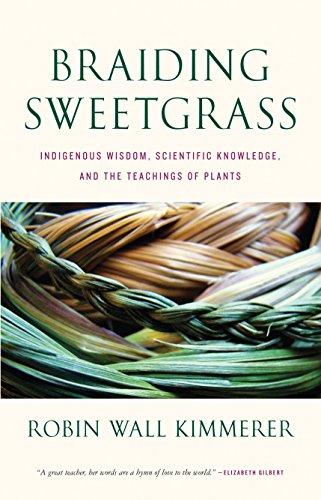Indigenous Wisdom, Scientific Knowledge, and the Teachings of Plants
“I fear that a world made of gifts cannot coexist with a world made of commodities.”

Robin Wall Kimmerer transcends boundaries, and so does her latest book. Simultaneously a botanist and author-poet, scientist and Potowatomi Nation citizen, professor and mother, she brings together unusually diverse perspectives and ways of knowing. The result is a gift to readers: beautiful writing exploring knowledge and ideas often buried in academia or dismissed as “unscientific.” As in her first book, Gathering Moss, her enthusiasm for nature and learning comes through strongly, a joy for any nature lover to read. She softens and contextualizes modern hard facts by relating them to indigenous worldviews developed over thousands of years. She reconciles art, appreciation of the natural world, and science (in many ways just now catching up to traditional knowledge.) Rejecting human exceptionalism, she considers all the beings with whom we share the earth while addressing deep questions of ethics and morality.
Braiding Sweetgrass draws on stories from elders and on Kimmerer’s own experiences for its 32 chapters. Each could stand alone, ranging across seemingly disparate subjects: relationships between masting nut trees and squirrels, gift economies vs market economies, the Haudenosaunee Thanksgiving Address, harvesting plants in a regenerative manner, and what it means to be a good citizen. But the chapters are tied together by recurring elements, most notably the titular sweetgrass. Sections entitled Planting, Tending, Picking, Braiding, and Burning Sweetgrass organize the individual chapters, and sweetgrass appears again and again as part of traditional legend, knowledge, and practice. The book is densely multilayered, with specific material practices seamlessly integrated into broader teachings about the physical world, and then into deep philosophy. The real magic comes from Kimmerer skillfully interweaving themes of relationship, gratitude, and responsibility into a story larger than the sum of the parts. Her art mirrors a well-lived life which has transformed individual experiences into holistic wisdom.
The overarching theme, drawn forth through the dozens of stories in hundreds of ways, is reciprocity. A fundamental difference between the culture of civilization and those of indigenous peoples is a mentality of exploitation vs one of gratitude. Derrick Jensen defines sustainability as giving back more than you take, and Kimmerer richly depicts a worldview in which that ethic is held first and foremost, even (or especially) when harvesting the lives of others. Her multiple detailed accounts, backed by science, of human interactions with other species to the benefit of all rebut the belief that humans are intrinsically destructive. We have the potential ― indeed, the responsibility ― to take up a supportive role in the web of life.
Building on this revelation, Braiding Sweetgrass challenges the reader to consider how an individual, or a culture, can become indigenous to place. With the vast majority of the earth under siege by settler cultures with a domination mindset, this is an urgent task. Sooner or later (hopefully sooner), collapse will render industrialism and globalization infeasible, reigning in civilization’s ecocide. But local cultures unable to develop reciprocal relationships with their landbases are doomed to continue the destruction, even if at a smaller scale.
Perhaps the most important lesson is that everyone has gifts. Birds have the gift of song, stars the gift of shining. But with each gift comes a responsibility to use it in the service of life. Birds have a responsibility to greet the day with music, stars to guide night travelers. What gifts do humans have, and what responsibilities? And more personally: as Carolyn Raffensperger asks, “What are the largest, most pressing problems that you can help to solve using the gifts that are unique to you in all the universe?” With the world at stake, contemplate the question. Find your answer. Then take action.
Braiding Sweetgrass is available as a paperback, ebook, and audio book.
Derrick interviewed Robin Wall Kimmerer for the September 25, 2016 episode of Resistance Radio. Readers who enjoy Braiding Sweetgrass will probably also enjoy Derrick’s The Myth of Human Supremacy, and vice versa.



